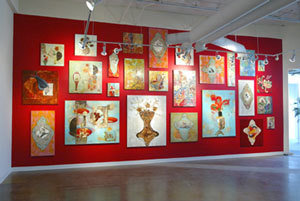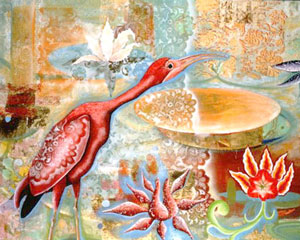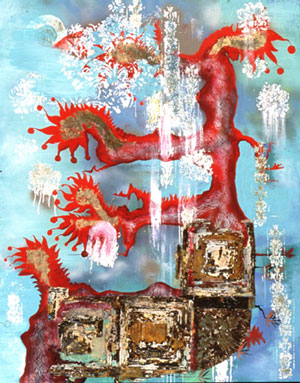A patch of animal fur on one painting was what first caught my eye. When I read the title, Still Life with Buffalo Fur, I was hooked. At 6 x 4 feet, it is among Steven Shores’ largest works.
Against a predominantly turquoise background, Shores has mounted a pedestal vase made from what appears to be resin, poured into a mold of old tin ceiling tiles. Thin sheets of this crinkly, rusty stuff show up in almost all of his paintings. Orange and red flowers of no known variety, painted flat and bright, extrude from the vase, and collaged velveteen fabric in a silly leaf print provides a touch of green. It almost goes without saying that gold leaf is also involved. The buffalo fur itself forms a bushy passage between vase and flowers. It’s the sort of gratuitous gesture that holds the work together.
This still life joins 26 other Shores paintings in a salon-style hanging on one of the spacious walls of Conduit’s new Chelsea-sized gallery. Shores has painted the wall red. It’s a bravura gesture, flamboyant and a little dandified. But the hanging wouldn’t work without it. Like the painting already described, every work on the wall comes loaded with pattern, collage elements, and dizzying color. Standing there under assault, I felt I had been transported back to Holly Solomon Gallery circa 1980. That might not sound so appealing to a lot of people these days, but I confess that artists like Robert Kushner and Kim McConnell have always been among my guilty pleasures. And pleasure is what these current paintings are all about.
Six large paintings from 2000 – 2002 hang on other walls, but on the red wall there are paintings from as early as 1998. This mini-retrospective approach gives you a sense of how Shores is developing. The earliest works have a cartoony style with goofy characters and pop culture references. They are appealing, but a bit coy. Then he seems to have discovered books of natural history illustration, and decoupaging pages of these onto his canvases set loose his playful decorative instincts. Shores also works on film and theater sets, and so he has a vast battery of techniques at his command. He knows how to make things “read.” Our feathered friends wind up surrounded by fields of psychedelic color and pools of the resinous material Shores pulls from tin ceiling tiles. Cotton balls dangle from some paintings. The sanded and abraded surfaces reveal patterns under patterns and colorful underpainting. When he paints a bird or two himself, rather than clipping the image from a book, he tattoos them with elegant designs. His is a “more is more” aesthetic, one tenet of which is: When in doubt, add glitter.
Since Shores titles most paintings after their animal subject, the checklist reads like the table of contents to a book on Audubon: Rad Tanger. Eskimo Plover. Snow Weasel. Puffins. These are mixed with the still lifes: Silk Flower Still Life. White Corset Still Life. Reading over the titles helped me get a grasp of what I think Shores is up to. Still Lifes and Wildlife subjects: the kinds of paintings the public likes. But Shores delivers those paintings on acid.
Not that I think these works are meant to comment on or subvert popular, conservative taste. That would be too petty and mean-spirited a project. But it seems that Shores enjoys turning himself loose on traditional subject matter. The scarlet ibis in a painting by the same name is his excuse to use a lot of pink paint. He can be at once true to the subject with a realistic pose, while turning its neck feathers into bristly fur and rendering a delicate lace pattern on one of its wings. The bird’s habitat is all lush yellows and golds, where what might be plant life resembles decorative pots.
These paintings are inexcusable. And I mean that in the best way. They are extravagant and self-indulgent, and at times they dare you to like them. I keep coming back to that resinous material Shore uses again and again. It can have a kind of luxe effect in some paintings, but at times it also bears more than a passing resemblance to plastic vomit. That said, the paintings wouldn’t work if it didn’t. The ones that don’t work for me (and in a exhibition of 32 paintings there are of course many that don’t work) just seem too easy, an exercise in one or two decorative effects. They have to cross some lines, and cross them with gleeful abandon.
There has been much talk about beauty here of late. (Or is that already over?) In this discourse, beauty is the agency that slips in inadmissable content or allows an unpopular argument to be made. Steven Shores makes a case for the pleasures of pure sensation. It’s an anti-puritanical stance that can leave the viewer, this viewer at least, a little giddy with delight.
Images courtesy the artist and Conduit Gallery.
Charles Dee Mitchell is a writer living in Dallas, Texas.






